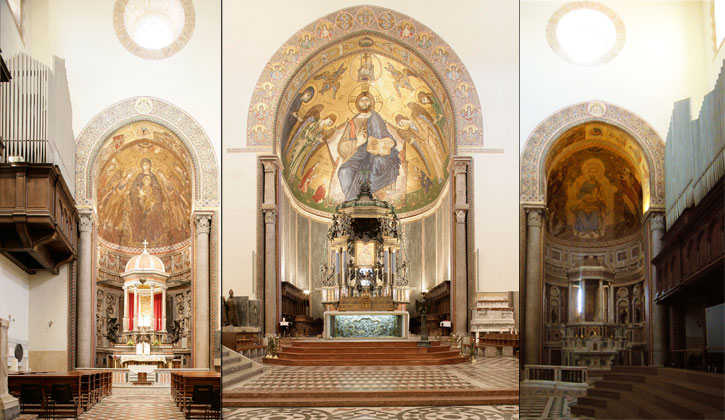
The transept is slightly widened to form a Latin cross.
The apses are decorated with mosaics. The original 14th century mosaic on the left apse bowl, portrays the Virgin Theotokos; the Virgin Mary holds Baby Jesus; on the left are St. Agatha and the Archangel Michael; on the right St. Lucy and the Archangel Gabriel; kneeling, below the Archangels’ hands are Queen Eleanor and Queen Elisabeth of Aragon. Below the arch, there are representations of eight virgin Saints.
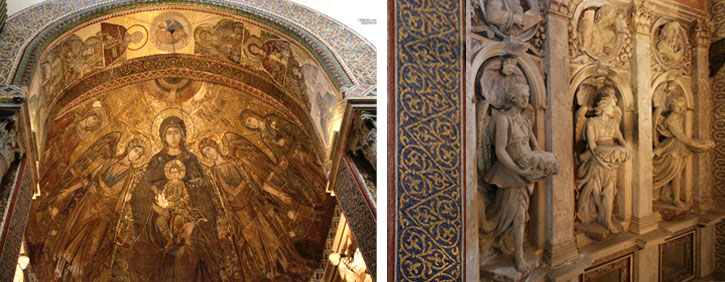
The apse has a rich stuccos decoration, made in 16th century from the design by Jacopo del Duca. Above the border on the base, statues of angels bearing baskets of fruit adorn the niches; higher up, marble circles enclose medallions with relief busts of the Prophets and the Evangelists. The Chapel of the Relics stands behind the 18th century altar.
The tomb of Archbishop Paino stands immediately on the right of the apse. The monument was made by M. Lucerna and A. Indelicato in 1968. It shows the prelate standing on reinforced concrete beams, symbols of the reconstruction of the city.
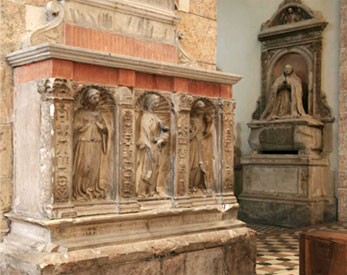
The Chapel of Piety stands on the left of the apse. Originally made in 16th century, by A. Gagini and G.B. Mazzolo, was quite completely destroyed during the Second World War. The lower part of the Chapel hosts the original sarcophagus of Archbishop La Lignamine, framed by bas-reliefs depicting the Stations of the Cross.
Giovan Battista Mazzolo even created the tomb of Archbishop Pietro Bellorado, in 1513. The nephew of the Archbishop, Giovanni Ruiz, commissioned it. The basement is decorated with the statues of the three theological Virtues. The Bishop laid in pontificals on a richly decorated sarcophagus. The 1943 fire destroyed it, and only the fragment of the head is still visible.
A gilded bronze canopy stands in the main apse. Begun in 1628 on the design by Simone Gullì, it was destroyed by the Second World War fire.
The painting of the Madonna of the Letter, in the centre of the canopy, is the work of Adolfo Romano, 1947. The silver cover, which is placed on the painting, is by Giuseppe Catanzaro, 1949.
The mosaic on the apse bowl, originally made in 14th century, shows Christ on His Throne, giving a blessing in the Greek manner. On either side of Christ, facing Him, are the Virgin Mary and the Archangel Michael on the left with Frederick II of Aragon and Archbishop Guidotto de Abbiate kneeling, and St. John the Baptist and the Archangel Gabriel on the right with Peter II of Aragon below. The actual mosaic is a post-war reproduction of the original.
The Coram populo altar is decorated with an altar frontal depicting the Madonna giving Her message to the Messinese ambassadors. At the sides of the altar frontal there are the female figures symbolizing Faith and Fortitude. Dated 1769.
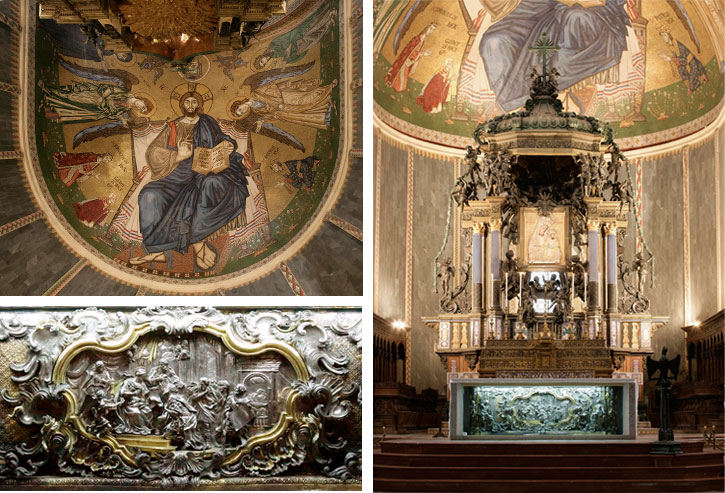
Facing the altar, before the triumphal arch there is on the left the Archbishop’s Throne. Opposite it the Tomb of Archbishop Letterio D’Arrigo Ramondini, made by Zocchi in 1929 and rebuilt after the Second World War. The Archbishop is represented consoling and blessing the 1908 earthquake survivors.
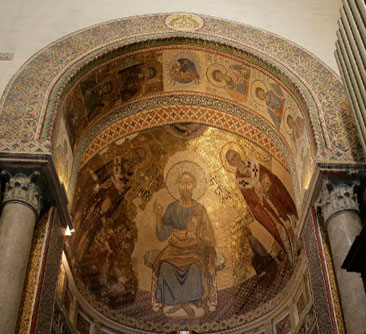
The right apse is decorated with bronze cherubim, a 17th century work by Innocenzo Mangani. The mosaic on the apse bowl represents St. John the Evangelist between St. Nicholas and St. Minas, Ludovico King of Aragon and Giovanni, Duke of Randazzo are kneeling in the foreground. Only the lateral, darker parts of the mosaic are original and date from the 14th century, while the central part is a post-earthquake reproduction.
On the left of the apse, there is the tomb of Archbishop Guidotto de Habbiate, by Goro di Gregorio, 1333. On a basement, four bas-reliefs depict from left to right the Crucifixion, the Annunciation, the Nativity and the Whipping of Christ.
In front of the tomb of Archbishop de Habbiate, the organ console stands. The cathedral organ is the largest organ in Italy. It has 5 keyboards, 170 registers, 16.000 pipes situated on either side of the transept, behind the baldachin, over the main door and over the triumphal arch. It was made by the Tamburini firm of Crema and was inaugurated in 1948.
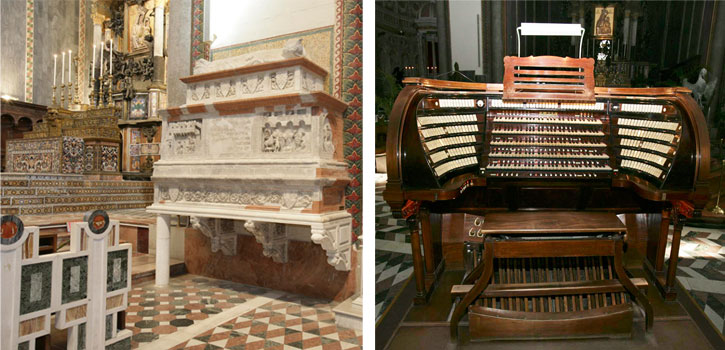
Behind the organ console, the tombstone of Archbishop Richard Palmer can be admired. Originally placed in the former Cathedral of Saint Nicholas, it was badly damaged by the 1943 fire. It has three round medallions, carved into the stone, which depict the Virgin Mary, Christ Enthroned, and the deceased bishop. An inscription round the edge of the stone tells of Richard Palmer’s life and the date 1195.
